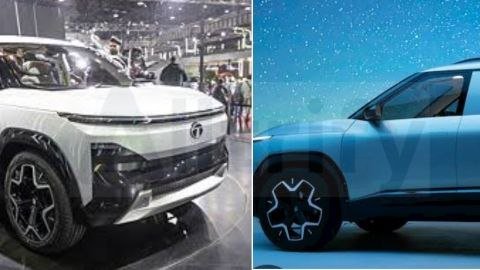The Tata Sierra and Tata Safari hold significant positions in the portfolio of Tata Motors, symbolizing distinct phases of automotive evolution within the brand. The Tata Sierra, originally launched in the early 1990s, was a pioneering SUV that captivated the Indian market with its innovative design and practical functionality. It became an emblem of style and robust performance, catering to a growing demographic looking for versatile vehicles. Recently, at the Auto Expo 2025, Tata Motors revived the Sierra nameplate, introducing a modern iteration that pays homage to its heritage while integrating contemporary features and design elements.
Table of Contents
Tata Sierra and Tata Safari
On the other hand, the Tata Safari made its debut in the late 1990s and quickly established itself as a prominent player in the SUV segment. Its spacious interiors, powerful engine options, and commanding road presence quickly positioned the Safari as an ideal choice for families and adventure seekers alike. The Safari’s design has evolved significantly over the years, adapting to changing consumer preferences yet maintaining its core identity. This evolution reflects Tata Motors’ capability to innovate while staying true to its roots, ensuring the Safari remains a beloved choice among automotive enthusiasts.
The resurgence of the Sierra alongside the established Safari illustrates Tata Motors’ strategy to blend nostalgia with modernity. While the Sierra attracts attention with its retro-inspired charm and state-of-the-art technology, the Safari continues to cater to well-established customer expectations of comfort and reliability. Both vehicles exemplify Tata’s commitment to delivering quality and performance, enriching the automotive landscape in India. As we delve deeper into the design elements and features of these vehicles, we will uncover how they reflect Tata Motors’ vision and values in delivering exceptional SUVs to the market.
Design Language and Aesthetic Comparison
The design languages of the Tata Sierra and Tata Safari showcase the evolution of Tata Motors’ aesthetic philosophy, catering to different market segments while embodying individual identities. The Tata Sierra, a revival of the iconic model, embraces a retro-inspired design that pays homage to its heritage. Key design elements, such as the rounded contours and the classic silhouette, evoke nostalgia, reflecting a bygone era of SUV styling. The front fascia features a distinctive grille that complements the circular headlamps, enhancing the model’s vintage appeal. Additionally, the Sierra’s body proportions are balanced, giving it a robust appearance that is further accentuated by its neatly integrated door handles and thoughtfully designed alloy wheels, which echo the classic aesthetics without compromising modern functionality.
In contrast, the Tata Safari exemplifies a more contemporary approach, characterized by its modern, angular design language. The Safari’s front fascia is aggressive and bold, incorporating a prominent grille flanked by sharp, LED headlamps. This gives the SUV a powerful presence on the road. The body proportions are also more dynamic, with a longer hood and a sloping roofline that contribute to its athletic stance. Furthermore, the door handles and alloy wheel designs are sleek and stylish, aligning with current automotive trends while ensuring functionality. The Safari emphasizes a forward-thinking design, appealing to a younger demographic looking for sportiness fused with practicality.
Both vehicles showcase meticulous attention to detail and craftsmanship, representing Tata Motors’ commitment to quality and innovation. While the Sierra’s design resonates with those who appreciate traditional aesthetics, the Safari’s sleeker lines and modern elements capture the essence of modernity. This dichotomy highlights the diverse appeal of Tata’s offerings, allowing consumers to select an SUV that best fits their personal style and preferences.
Functional Aspects and Practicality
The design of an SUV significantly influences its functional aspects and practicality, which are critical for everyday usability. In comparing the Tata Sierra and Tata Safari, one can discern notable differences that cater to varying consumer needs and preferences. The boxy shape of the Tata Sierra contributes to a more spacious interior, offering generous headroom and legroom. This design choice is particularly advantageous for families or individuals requiring extra space for passengers or cargo. The Sierra’s shape also translates to a more utilitarian approach, which attracts buyers looking for functionality over form.
In contrast, the Tata Safari’s design leans towards a more rugged aesthetic, featuring a pronounced and busy rear design. This design, while visually striking, can reduce the cargo capacity compared to the Sierra. Nevertheless, the Safari’s cargo area is designed to accommodate various loads, making it appealing for outdoor enthusiasts and urban dwellers alike. The unique rear window shape of the Safari not only enhances its style but also contributes to improved visibility while driving, thereby offering a better overall driving experience.
Aerodynamics play a pivotal role in the design of both SUVs. The boxy design of the Sierra, while spacious, may have implications for wind resistance, potentially affecting fuel efficiency on the highway. Conversely, the Safari’s more contoured lines may help in reducing drag, thus improving its performance and fuel economy. However, this might come at the expense of maximum interior space. Each design choice impacts factors such as usability, comfort, and performance, which ultimately defines the appeal of the Tata Sierra and Tata Safari for their respective customer segments.
Market Positioning and Rivalry
The market positioning of the Tata Sierra and Tata Safari reveals the strategic intentions of Tata Motors within the competitive landscape of SUVs. The Sierra is anticipated to enter the compact SUV segment, aiming for a starting price around Rs 11 lakh. This pricing strategy places it in direct competition with segment leaders such as the Hyundai Creta and Kia Seltos, both of which have established their dominance through a combination of modern design, feature-rich offerings, and brand reputation. Meanwhile, the Tata Safari, positioned in the mid-size SUV price range, faces competition from offerings like the Mahindra XUV700, which has garnered attention for its performance and features.
The distinct market positioning of these two models reflects Tata’s commitment to capturing diverse consumer segments. The Sierra’s entry into the compact SUV market not only diversifies Tata’s portfolio but also enhances its competitiveness against similarly priced rivals. This segment is characterized by consumers seeking a balance between affordability and advanced features, making the Sierra’s design and tech offerings critical for its success. Conversely, the Safari’s established presence in the mid-size category enables Tata to leverage brand loyalty while catering to families and individuals looking for more spacious and capable vehicles.
Furthermore, the implications of their design on consumer choices cannot be overlooked. The Tata Safari’s bold and robust design has already earned it a place among loyal customers, while the innovative approach of the Sierra’s design could attract a newer, younger demographic. As the compact SUV segment continues to flourish, Tata Motors must ensure that both models effectively communicate their unique selling propositions. Ultimately, the competition is not only about pricing but also how well these vehicles resonate with potential buyers looking for style, functionality, and brand identity in their vehicle choice.





